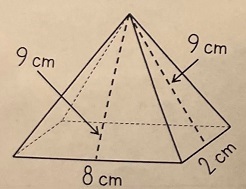I saw this on my niece's homework (she's in middle school), and I can't seem to get a surface area that matches all the online rectangular pyramid surface area calculators.
Anyway, here are the dimensions of the pyramid:
The rectangular base: 8 cm by 2 cm.
The two larger triangles: 8 cm across, with a "midpoint height" of 9 cm (that is, if you draw a line on the surface of the triangle from the midpoint of the 8 cm side to the opposite vertex, that length is 9 cm).
The two smaller triangles: 2 cm across, with a "midpoint height" of 9 cm (if you draw a line on the surface of triangle from the midpoint of the 2 cm side to the opposite vertex, the length is 9 cm).
Here is an image:

So, what I did was just calculate the surface area of the four triangles, and the surface area of the base, and add it all together.
Bigger triangle: (1/2) * 8 cm * 9 cm = 36 cm2
Smaller triangle: (1/2) * 2 cm * 9 cm = 9 cm2
Area of base: 8*2 = 16 cm2
Since there are two of each type of triangle, the total area should be:
2 * 36 cm2 + 2 * 9 cm2 + 16 cm2 = 106 cm2.
.
.
However, every rectangular pyramid calculator I put that in gives me either a surface area of about 108 cm2 or about 105.99 cm2, depending on which triangle I use to calculate the perpendicular height (altitude) — which I calculate as EITHER the square root of {(slant height)2 - (width/2)2}, which is about sqrt(92 - 12) = 8.944 cm, or {(slant height)2 - (length/2)2}, which is about sqrt(92 - 22) = 8.78 cm
The only way I get a matching answer with what I did above (calculating the area of each triangle and the rectangular base, then adding them all up) is by using the latter height. Why is this? Is my initial value of 106 cm2 incorrect?
.
.
.
Thanks for this reading this convoluted post, and any insight you have.
Anyway, here are the dimensions of the pyramid:
The rectangular base: 8 cm by 2 cm.
The two larger triangles: 8 cm across, with a "midpoint height" of 9 cm (that is, if you draw a line on the surface of the triangle from the midpoint of the 8 cm side to the opposite vertex, that length is 9 cm).
The two smaller triangles: 2 cm across, with a "midpoint height" of 9 cm (if you draw a line on the surface of triangle from the midpoint of the 2 cm side to the opposite vertex, the length is 9 cm).
Here is an image:

So, what I did was just calculate the surface area of the four triangles, and the surface area of the base, and add it all together.
Bigger triangle: (1/2) * 8 cm * 9 cm = 36 cm2
Smaller triangle: (1/2) * 2 cm * 9 cm = 9 cm2
Area of base: 8*2 = 16 cm2
Since there are two of each type of triangle, the total area should be:
2 * 36 cm2 + 2 * 9 cm2 + 16 cm2 = 106 cm2.
.
.
However, every rectangular pyramid calculator I put that in gives me either a surface area of about 108 cm2 or about 105.99 cm2, depending on which triangle I use to calculate the perpendicular height (altitude) — which I calculate as EITHER the square root of {(slant height)2 - (width/2)2}, which is about sqrt(92 - 12) = 8.944 cm, or {(slant height)2 - (length/2)2}, which is about sqrt(92 - 22) = 8.78 cm
The only way I get a matching answer with what I did above (calculating the area of each triangle and the rectangular base, then adding them all up) is by using the latter height. Why is this? Is my initial value of 106 cm2 incorrect?
.
.
.
Thanks for this reading this convoluted post, and any insight you have.



